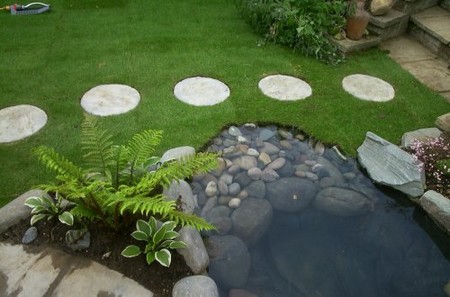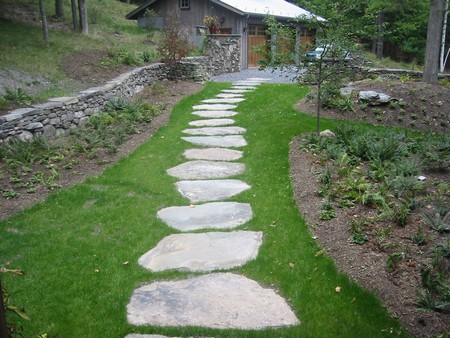As most (human) visitors to a pond will stand on the edge and look towards the other side, across the surface of the water, one can miss beauty and activity practically at one’s feet. Stepping stones can change all that: from here one can look back towards the pond edge.
Whilst stepping stones are generally meant for access across the pond, and so are designed to be in more or less a straight line, a useful design trick is to cluster a few of them to provide a better viewing (and maintenance) platform.
If the size of your pond allows, go for large stones that you can stand on with both feet or, even better, that you can crouch or kneel on. This will enable you to enjoy the pond at close quarters for a longer time.

Supporting the stones within the pond is not always easy, but the stones must always end up perfectly stable and level, with no chance of them toppling over. This means that each must have a plinth or column virtually the same size as the stepping stone, allowing for only a minimal overhang. Each column has to be built up from the floor of the pond and end at a point where the stepping stone appears to float on the surface of the water.
Building onto the floor of a concrete pond is easy. A vertical column of bricks, blocks or stone can be simply built up – using mortar – to the required height.
Ponds made from flexible liners are a little more tricky. It is not ideal to place mortar directly onto the single layer of the base liner as pool liners may be damaged if the ground underneath has not been suitably prepared, so a further protective film – perhaps thick PVC – should be placed on top of the liner before the column is built up on a thick bed of soft sand mortar.
Pre-moulded pools may have been installed with air gaps underneath – sometimes this is unavoidable. If a heavy weight, such as a stepping stone pillar, is applied directly over these, the plastic could buckle and split. It can, therefore, be risky placing columns in these pools.

Pieces of natural stone fit well into natural or informal ponds, and are available in all sorts of shapes and sizes, but they may eventually become rather slippery and, therefore, hazardous. There are obviously plenty of manufactured slabs to choose from – square, round, rectangular, hexagonal – but they are all of a limited size.
Timber decking squares can be used, but not if they have been treated with any toxic substances, which might wash off into the water. Hardwoods, cedar or any other naturally resilient timbers, are better than pressure-treated softwoods.